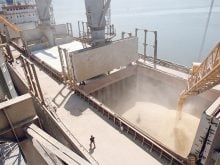WINNIPEG — A Vancouver agri-tech company wants to give canola growers another weapon in the never-ending battle against flea beetles.
Renaissance BioScience has developed a distinct RNAi technology that interferes with biological processes in a pest.
In early September, Renaissance announced that the federal government is providing $830,000 to fund a $1.65 million project, which is called Eco-Friendly Precision: Innovation RNAi Encapsidation for Flea Beetle Control.
Read Also

VIDEO: Agritechnica Day 4: Robots and more robots, Nexat loves Canada and the trouble with tariffs
Agritechnica Day 4: Robots and more robots, Nexat loves Canada and the trouble with tariffs.
The project name is complicated, but the goal is simple.
“This project aims to provide canola farmers with a cost-effective, sustainable alternative to chemical pesticides,” Renaissance said in a press release.
“Once developed and approved, this made-in-Canada biocontrol innovation will be commercially available to farmers worldwide, offering a powerful new tool to protect yields, cut costs and align with the global shift toward eco-friendly agriculture.”
Flea beetles are the most damaging pest for canola growers on the Prairies. The insects can devour an entire field of emerging canola plants in May or early June. Farmers rely on insecticides coated on canola seeds and foliar sprays of insecticides to control the beetles.
Many companies around the globe, including Renaissance, have been looking at RNAi as a solution to pest control in crop production.
RNA interference is a biological process that regulates gene expression. It interferes with messenger RNA that carry genetic instructions for critical functions, such as making new proteins.
The interference can turn off genes and reduce the levels of specific proteins, which a pest needs to survive.
The big advantage of RNAi is it’s highly specific. It harms the crop pest rather than other species.
Scientists and innovators know that it’s effective, but the difficulty has been delivering the RNAi molecule in a cheap and effective manner.
Renaissance is using yeast to deliver the RNAi to the pest.
“The yeast acts as a ‘suitcase’ to protect the fragile bioactive in the environment, allowing the RNAi yeast to be sprayed in solution onto plant leaves like a conventional pesticide,” John Rusnik, Renaissance’s chief scientific officer, told Agribusiness Global in April.
The idea is that the flea beetle would chew on the leaves of a canola plant and consume the RNAi yeast.
Then, the RNAi gets into the gut of the beetle, switching off specific genes and killing the pest.
Renaissance has already been testing this technology on the Colorado potato beetle, an annoying pest for potato growers around the world.
In 2023, the Pest Management Regulatory Agency approved field studies of the yeast-based RNAi on the Colorado potato beetle.
“Independent bench-top laboratory testing on the RNAi technology… (had) a 98 per cent mortality rate that delivered excellent protection for potato plant defoliation,” says a Renaissance press release.
Last September, the Vancouver company was recognized for its unique pest control technology. AgTech Breakthrough, a market intelligence firm, awarded Renaissance with the Crop Protection Solution of the Year.
Renaissance will work on its flea beetle project until 2028, which is partially funded by Agriculture Canada and the Sustainable Canadian Agriculture Partnership.
“This made-in-Canada solution will protect canola yields, open new opportunities across the value chain and support economic growth in our rural communities,” said federal agriculture minister Heath MacDonald.
For now, the agri-tech company is focusing its efforts on “leaf munching pests.”
“We are fine-tuning our technology to make it suitable for pests that devastate fruit, vegetable, grain and oilseed crops.”
















